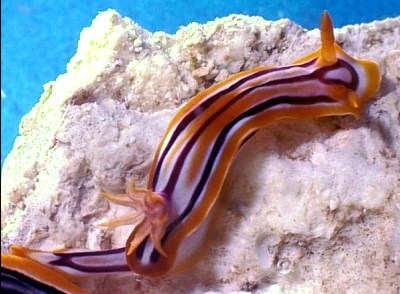
Hypselodoris regina
Marcus & Marcus, 1970
Order: NUDIBRANCHIA
Suborder: DORIDINA
Superfamily: EUDORIDOIDEA
Family: Chromodorididae
DISTRIBUTION
Western Indian Ocean
PHOTO
UPPER RIGHT, LOWER LEFT: 32 mm long alive, Pangavini Island, off Kunduchi Bch, Dar es Salaam, Tanzania, Oct 1976. LOWER RIGHT: 40mm long alive, Ras Kankadya, Dar es Salaam, Tanzania, 2 November 1975. PHOTOS: Bill Rudman.
This species is very similar in colour to species of the Chromodoris quadricolor colour group, such as C. hamiltoni and C. elisabethina, with three black or dark purple longitudinal lines, a bluish background and an orange border. Its internal anatomy clearly differentiates it a s a species of Hypselodoris. Details of the colour pattern which are characteristic of this species are the ring that the median black line forms anteriorly between the rhinophores and the diffuse orange longitudinal markings on either side of the median black line. The bluish white gills are triangular in cross section and edged with orange. On the outer face distinctive white spots can sometimes be seen.
References:
•Rudman, W.B. (1977) Chromodorid opisthobranch Mollusca from East Africa and the tropical West Pacific. Zoological Journal of the Linnean Society, 61: 351-397.
•Rudman, W.B. (1982) The Chromodorididae (Opisthobranchia: Mollusca) of the Indo-West Pacific: Chromodoris quadricolor, C. lineolata and Hypselodoris nigrolineata colour groups. Zoological Journal of the Linnean Society, 76: 183-241.
•Gosliner, T.M. & Johnson, R.F. (1999) Phylogeny of Hypselodoris (Nudibranchia: Chromodorididae) with a review of the monophyletic clade of Indo-Pacific species, including descriptions of twelve new species. Zoological Journal of the Linnean Society, 125: 1-114.
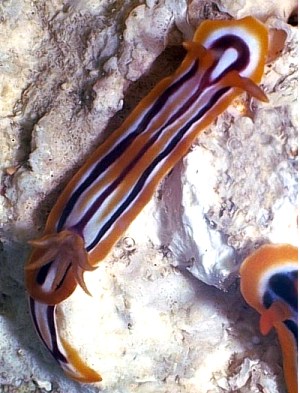
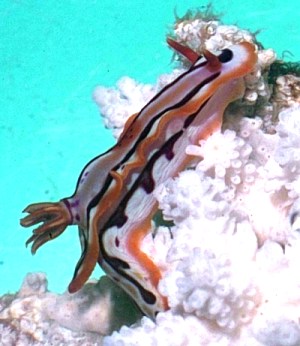
Rudman, W.B., 2000 (January 17) Hypselodoris regina Marcus & Marcus, 1970. [In] Sea Slug Forum. Australian Museum, Sydney. Available from http://www.seaslugforum.net/find/hypsregi
Related messages
Hypselodoris regina from Mozambique
November 22, 2007
From: David Abecasis
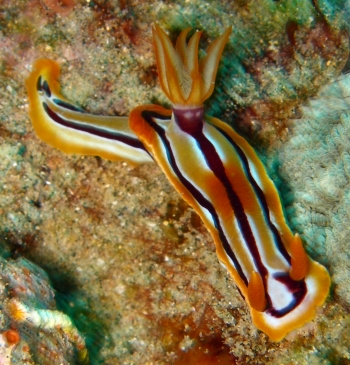
Hello Bill,
I found this nudibranch and I have identified as Chromodoris africana but I am having some doubts as it presents orange lines between the black ones.
Locality: Ponta do Ouro, 16 meters, Moçambique, Indian Ocean, 1 November 2007, rocky bottom. Length: about 30 mm. Photographer: David Abecasis.
Best regards,
David Abecasis
davidbecas@netcabo.pt
Abecasis, D., 2007 (Nov 22) Hypselodoris regina from Mozambique. [Message in] Sea Slug Forum. Australian Museum, Sydney. Available from http://www.seaslugforum.net/find/21141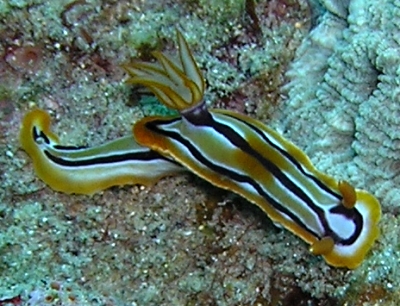
Dear David,
This is one of the group of species with black longitudinal lines which we call the Chromodoris quadricolor group, not because they are closely related to each other, but simply because they all look quite similar. The relatively narrow and high body shape of this species suggest it is a species of Hypselodoris rather than a Chromodoris and it is in fact Hypselodoris regina. The way the central black line forms a loop inside the rhinophores is quite characteristic of this species, as is the shape of the gills - triangular in cross section.
Best wishes,
Bill Rudman
Melanistic Chromodoris hamiltoni is H. regina
January 11, 2007
From: Bill Rudman
Concerning message #18677:
I have been puzzling over this identification for some time. I was pretty sure it was Chromodoris hamiltoni but if it was a Chromodoris the sponge the animals are clearly eating is a problem. It is a species of Dysidea, a genus of sponges which is not normally eaten by species of Chromodoris. On the other hand, it has similarities in colour to Hypselodoris regina and Erwin Koehler has sent photos [message #13953 ] of a quite similar looking pair of animals which I had previously identified as H. regina. In Erwin's photos they are feeding on the same sponge, a genus commonly eaten by species of Hypselodoris.
Although I would need to look at the anatomy to be certain, it seems as though these animals are a colour variation on Hypselodoris regina Interestingly, the only reference I have to feeding in C. hamiltoni is to it feeding on a species of Negombata [ as Latrunculia sp], a red sponge similar in appearance to the red sponges in the upper half of the photo (Pika & Faulkner, 1995). If it weren't for the everted buccal bulb of one of these animals on to the bluish Dysidea I would have considered this photo to be too ambiguous to identify either the nudibranch or the sponge.
-
Pika, J. & Faulkner, D. J. 1995. Unusual chlorinated Homo-Diterpenes from the South African nudibranch Chromodoris hamiltoni. Tetrahedron, 51: 8189-8198.
Bill Rudman
Rudman, W.B., 2007 (Jan 11) Melanistic Chromodoris hamiltoni is H. regina. [Message in] Sea Slug Forum. Australian Museum, Sydney. Available from http://www.seaslugforum.net/find/19207Re: Melanistic Chromodoris hamiltoni
November 30, 2006
From: Colin Ogden
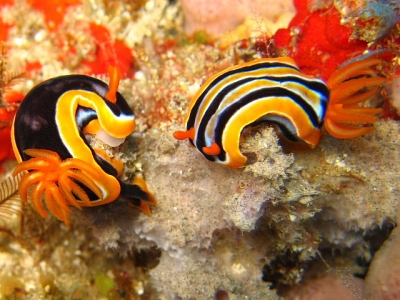
Concerning message #15570:
Hi Bill,
One of our customers managed to get this picture of another "melanistic" nudibranch next to a "friend". They both seem to be feeding on the same sponge together, but this one shows a much more distiguishable blue stripe on its foot comparde to the previous nudi.The second picture is the original one I found. I battle to tell the difference between a C. hamiltoni and a C. quadricolor. Which one is this?
Locality: Sodwana Bay, 22 meters, South Africa, Indian, 25 november 2006, reef. Length: 40mm. Photographer: Trevor Hodgson.
Thanks for all your help so far.
regards
Colin
scubaco@iafrica.com
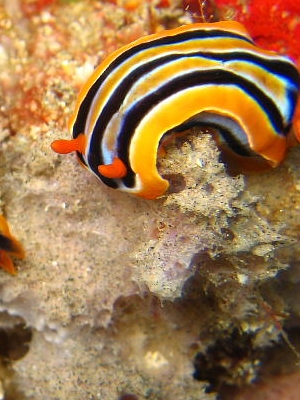
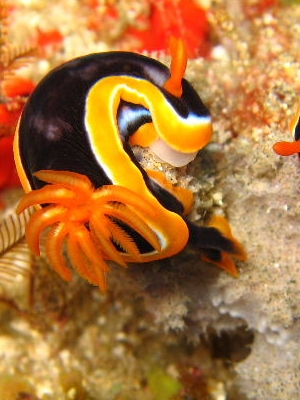
Noted added 11 January 2007: This is most probably Hypselodoris regina. See message #19207.
Dear Colin,
It is a bit difficult to identify some of these species externally. C. hamiltoni is usually more compact with a narrower mantle skirt than C. quadricolor and it often has the secondary then black lines on the mantle which are often replaced by wider orange or brownish lines. Interestingly, C. quadricolor seems to feed exclusively on the bright red sponge Negombata, while your animals here are feeding on a species of Dysidea.
I am confident that both these animals are C. hamiltoni, and both appear to be feeding on the same colony of sponge, the melanistic one actually has its buccal bulb everted. This is a nice find..
Best wishes,
Bill Rudman
Hypselodoris regina from Sth Africa
June 26, 2006
From: Riaan Marx
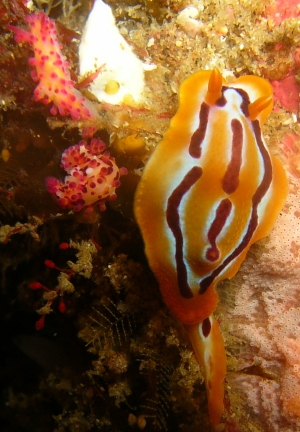
Hi Bill,
I took this photo of Hypselodoris sp.3. But when I examined the photo on my PC (like so often) I noticed the two critters on the left. (where did they come from?)
Well I had a long look in the forum and could not ID them, so I was hoping you would help me out here with a name. Also, note the texture on the Hypselodoris highlighted by the flash. I don't know if this is the norm, but it is something I have not noticed before.
Locality: Sodwana bay, 9-mile reef, 17.5 metres, South Africa, Indian, 18 June 2006, Rocky reef. Length: 10mm and 45mm. Photographer: Riaan Marx.
Kind regards,
Riaan
rmarx@aasa.co.za
Marx, R., 2006 (Jun 26) Hypselodoris regina from Sth Africa. [Message in] Sea Slug Forum. Australian Museum, Sydney. Available from http://www.seaslugforum.net/find/16962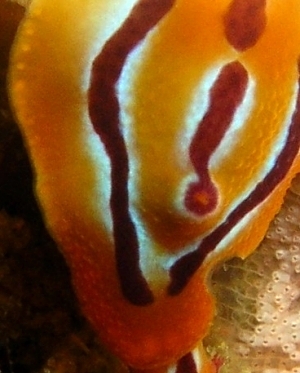
Dear Riaan,
This is Hypselodoris regina which you have previously noted from Sth Africa [message #13592]. The two animals on the left appear to be Aegires villosus.
The texture highlighted by the flash is quite unusual. If it were a mammal I would suggest it was cold. From my experience, little bumps like this aren't always present on H. regina, but they do occur at times on other species. I am afraid I have no idea of their purpose, if any, or what causes them.
Also visible in the close-up alongside are the discrete spherical mantle glands around the mantle edge. You can see quite small ones on the left hand side, and the outline of much larger ones clustered at the posterior tip of the mantle.
Best wishes,
Bill Rudman
Hypselodoris regina feeding
February 20, 2006
From: Colin Ogden
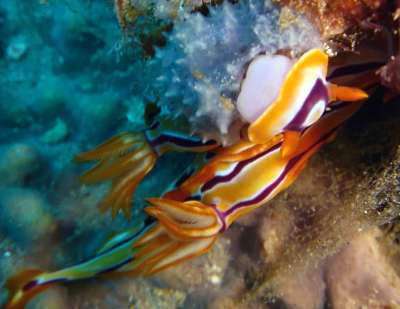
Hi Bill,
Thanks so much for your message on the H. toliara? I also noted your comment about all the unidentified nudi's we are finding here in South Africa. I know that Terry Gosliner spent a long time working here, but it is a real pity that there are so few people around the world working on these fascinating creatures. I really do appreciate the time you spend personally to keep us up to date with developments and to help us gain a bit of knowledge on these animals.
I attach a photo taken recently of 2 Hypselodoris feeding together. I think these also have not been described yet, but may be they have been completed. They are fairly common at the moment.
Locality: Sodwana Bay, 16 meters, South Africa, Indian Ocean coast, Feb 2006, Coral reef. Length: 35 mm. Photographer: Colin Ogden.
Thanks
Colin
scubaco@iafrica.com
Ogden C. M., 2006 (Feb 20) Hypselodoris regina feeding. [Message in] Sea Slug Forum. Australian Museum, Sydney. Available from http://www.seaslugforum.net/find/15891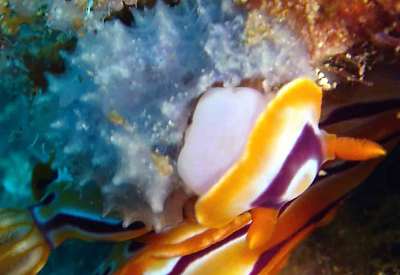
Dear Colin,
This is one we can put a name to. It is Hypselodoris regina which seems to be restricted to your side of the Indian Ocean. Nice to get a second record of it feeding on this species of Dysidea.
Best wishes,
Bill Rudman
Melanistic Chromodoris hamiltoni
January 16, 2006
From: Colin Ogden
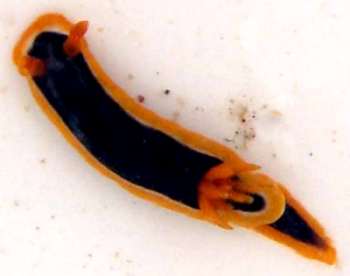
Hi Bill,
Welcome back and best wishes to you.
While you have been off line I have found a lot of nudis I cant id and have queries on, but have resisted flooding you with requests, but unfortunately I cant resist it any longer, so I will be passing them on at a slow rate. This one I found fairly close to a Chromodoris hamiltoni, but it is different enough to query. It was actually collected for our national parks display aquarium and then returned to the reef 4 days later.
Locality: Sodwana Bay, South Africa, Indian Ocean coast. Depth: 14 m. Length: 25 mm. Dec 2005. Coral reef. Photographer: Colin Ogden
Regards
Colin
scubaco@iafrica.com
Ogden C. M., 2006 (Jan 16) Melanistic Chromodoris hamiltoni. [Message in] Sea Slug Forum. Australian Museum, Sydney. Available from http://www.seaslugforum.net/find/15570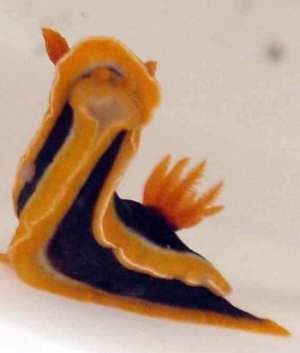
Noted added 11 January 2007: This is most probably Hypselodoris regina. See message #19207.
Dear Colin,
It's a bit hard to be sure but I suspect it is either C. hamiltoni or C. quadricolor. In either case the black pigment is clearly in excess. I can see traces of blue in your photos so I don't think it is an unnamed black species.
Best wishes,
Bill Rudman
Re: Chromodoris hamiltoni from Mozambique?
October 12, 2005
From: Bill Rudman
While doing a bit of 'house-keeping' I revisited Erwin Koehler's message #13953. On reflection I think this is more likely to be a slightly overcoloured Hypselodoris regina rather than Chromodoris hamiltoni. Both the black and orange seem more opaque than in typical H. regina, but I have not seen C. hamiltoni approaching this colour form, although it can have orange replacing part of the black bands at times..
Bill Rudman.
Chromodoris hamiltoni from Mozambique?
June 6, 2005
From: Erwin Koehler
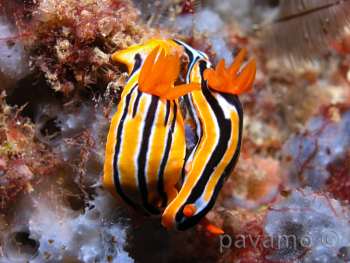
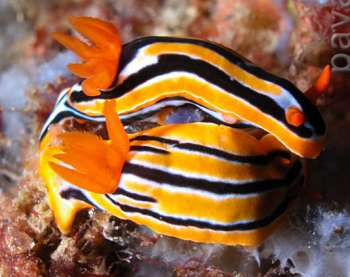
Dear Bill,
Is this one Chromodoris africana?
Locality: Chamber of secrets, Tofo Bay, Mozambique, Indian Ocean. Depth: 18 m. Length: 3 cm. 21 February 2005. Photographer: Patrick Van Moer
Regards Erwin
www.Philippine-Sea-Slugs.com
Erwin@Philippine-Sea-Slugs.com
Koehler, E., 2005 (Jun 6) Chromodoris hamiltoni from Mozambique?. [Message in] Sea Slug Forum. Australian Museum, Sydney. Available from http://www.seaslugforum.net/find/13953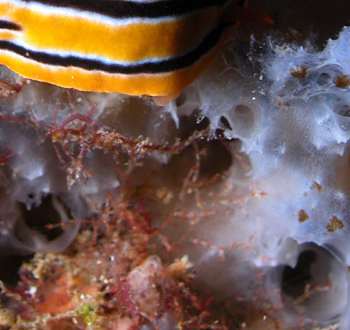
Note added 12 Oct 2005: On reflection, I think these are more likely to be Hypselodoris regina than C. hamiltoni. Both the black and orange seem more opaque than in typical H. regina, but I have not seen C. hamiltoni approaching this colour form. Bill Rudman.
Dear Erwin,
This is Chromodoris hamiltoni. I know these specimens seem to lack the blue found it that species, but there are some traces of it at least in one specimen. As you will see in photos on the species' Fact Sheet, the black lines can sometimes be replaced by orange. This population seems to have done that to excess. It's good to get these species on a possible food sponge which is a species of Dysidea.
Best wishes,
Bill Rudman
Hypselodoris regina from Mozambique?
June 6, 2005
From: Erwin Koehler
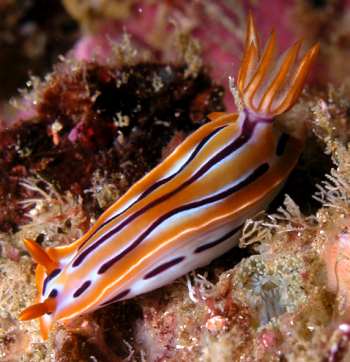
Dear Bill,
Is this one Chromodoris africana?
Locality: Chamber of secrets, Tofo Bay, Mozambique, Indian Ocean. Depth: 18 m. Length: 4 cm. 21 February 2005. Photographer: Patrick Van Moer
Regards Erwin
www.Philippine-Sea-Slugs.com
Erwin@Philippine-Sea-Slugs.com
Koehler, E., 2005 (Jun 6) Hypselodoris regina from Mozambique?. [Message in] Sea Slug Forum. Australian Museum, Sydney. Available from http://www.seaslugforum.net/find/13954Dear Erwin,
I'm afraid this isn't C. africana either. It is Hypselodoris regina, another of these black lined chromdorids. It has a much higher and narrower body than species of Chromodoris, and the gills are triangular in cross-section and edged in orange.
Best wishes,
Bill Rudman
Hypselodoris regina from South Africa
April 22, 2005
From: Riaan Marx
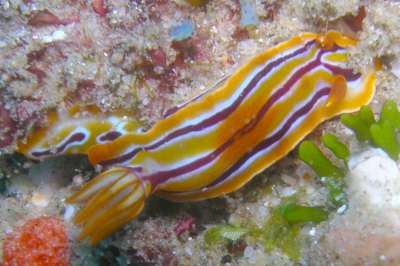
Hi Dr. Rudman,
I saw only 2 previous records on the Forum for this pretty little slug from South Africa, so I though I would add mine as well...
It was found about 1 m away from a specimen of Chromodoris elisabethina [message #13585 ], but neither were seen moving at all. I suspect the bad surge would have been the cause for that though.
Locality: 7-mile reef, Sodwana, South Africa, Indian Ocean. Depth: 21 m. Length: 50 mm. 15 Apr 2005. Rocky reef with sandy patches. Photographer: Riaan Marx
Regards
Riaan
v-riaanm@microsoft.com
Marx, R., 2005 (Apr 22) Hypselodoris regina from South Africa. [Message in] Sea Slug Forum. Australian Museum, Sydney. Available from http://www.seaslugforum.net/find/13592Dear Riaan,
It's nice to get another record of this species which seems to be endemic to the western Indian Ocean - but by saying that I will probably precipitate a flood of photos from further east.
Best wishes,
Bill Rudman
Hypselodoris regina from South Africa
February 16, 2004
From: Charles Rowe
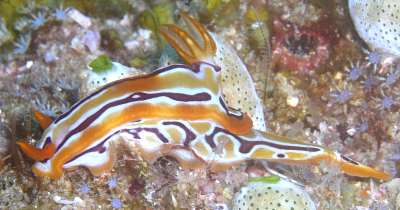
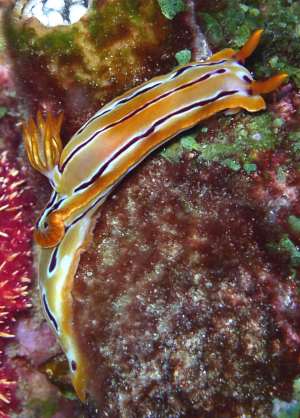
Hi Bill,
These are obviously the same species but were in different places on the same dive.
7 Mile Reef, Sodwana, KwaZulu Natal, South Africa. 7 January 2004.
Thanks for identifying my latest batch of nudis, I really appreciate the effort you put into it. These are my latest ones so until I photograph more they are the last for now. Hopefully I will get to dive this weekend as conditions are a little
better now.
See ya.
Charles ...
bumff@mweb.co.za
Rowe, C., 2004 (Feb 16) Hypselodoris regina from South Africa. [Message in] Sea Slug Forum. Australian Museum, Sydney. Available from http://www.seaslugforum.net/find/12225Dear Charles,
These are a nice find. It is Hypselodoris regina, a species which has seldom been reported since it was first described from Madagascar. I found some specimens in Tanzania in the 1970s, and Valda Fraser found one in KwaZulu Natal more recently [#1722], but I know of no other records.
Best wishes
Bill Rudman
Hypselodoris regina from South Africa
January 19, 2000
From: Valda Fraser
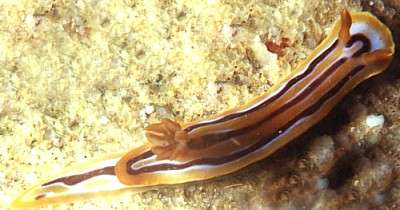
Dear Bill
A nudibranch which I have not come across before. Recently I have seen a few. It has a black longitudinal stripe all along it's foot.
Locality: South Coast KwaZulu-Natal, SOUTH AFRICA. Shelly Beach - 32m, 27 December 1999
Size: 60mm
Regards
Valda
iti04937@mweb.co.za
Fraser, V., 2000 (Jan 19) Hypselodoris regina from South Africa. [Message in] Sea Slug Forum. Australian Museum, Sydney. Available from http://www.seaslugforum.net/find/1722Dear Valda,
This is another interesting new record from South Africa. It is Hypselodoris regina, which previously was only known from the original record from Madagascar and my records from Tanzania.
Best wishes,
Bill Rudman.
